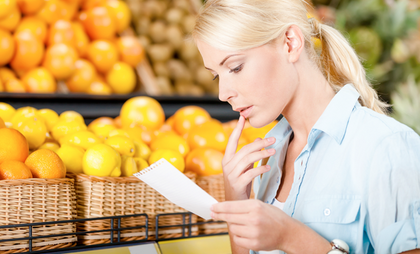Sla or lettuce... How Dutch is your shopping list?
Direct Dutch Institute recommends speaking Dutch as often as possible - even if all your Dutch colleagues speak English, and even if you only know a few words of Dutch.
To help you get started straight away, we offer some phrases to deal with the Dutch in day-to-day life. In this article: how to do your groceries in Dutch.
What does your shopping list look like? Do you write down groceries in your native language? Is it half-Dutch or English? Or do you refer to brands instead of products?
If you want to learn Dutch, we suggest, from now on, to do your shopping in Dutch only. To make it easy for you, here’s our ready-made shopping list, with translations. Daily groceries equals daily practice!
Learn Dutch while shopping
Shopping in a Dutch supermarket is an excellent way to extend your Dutch vocabulary. Not only will you learn new words every day, you will also learn Dutch customs on the go!
Just look at what your fellow shoppers throw in their baskets: drop, bloemkool, stroopwafels and the latest issue of Privé or Story (Dutch gossip magazines).
There are many advantages to shopping in a Dutch supermarket, as opposed to buying your favourite local products online or in a special expat store.
Not only is it easier and much cheaper, there’s another big plus: you may have noticed Dutch stores are continuously "at war" with one another to provide the customer with free collectables.
You certainly don’t want to miss out on the next hamsters, bungels, wuppies, gogo’s, stackies, welpies or beesies!
A (weekly) shopping list in Dutch
Here are some basic suggestions for your shopping list:
› Brood (bread)
› Stokbrood (baguette)
› Kaas (cheese)
› Boter (butter)
› WC-papier (toilet paper)
› Kattenvoer (cat food)
› Kattebakvulling (cat litter)
› Luiers (diapers)
› Baby-doekjes (baby wipes)
› Vuilniszakken (trash bags)
› Boterhamzakjes (sandwich bags)
› Vaatwastabletten (dish washer tablets)
› Wasmiddel (laundry detergent)
› Krat bier (beer crate)
› Pindakaas (peanut butter)
› Jam (marmelade / jelly)
› Eieren (eggs)
› Sla (lettuce)
› Aardappels (potatoes)
› Zeep (soap)
› Vissticks (fish fingers)
› Aardbeien (strawberries)
› Krant (newspaper)
› Chips (crisps)
› Tandpasta (toothpaste)
› Koffie (coffee)
› Bier (beer)
› Wijn (wine)
› Melk (milk)
› Yoghurt (yoghurt)
› Mayonaise (mayonnaise)
› Soep (soup)
› Appels (appels)
› Peer (pear)
A Dutcher-than-Dutch shopping list
Are you having friends over? Show off your new Dutch lifestyle by doing some Dutcher-than-Dutch grocery shopping!
Once you return home, decorate your bike with the collectables from the supermarket and park it in front of your house, so everyone can see!
Fill up your fridge and cupboard with more typical Dutch products than an average Dutch family can consume in a month. And forget what they say about Dutch people: buy all the Dutch cookies you can find and offer them to your guests. Not just one cookie. Lots of Dutch people eat lots of cookies.
But beware! One Dutch product deserves a special warning: drop (liquorice). Drop is delicious, once you’re used to it. But gentlemen, if you want to know what contractions feel like, just eat a whole bag of sugar free drop (note to self: NEVER buy sugar free drop again, I repeat, NEVER buy sugar free drop again!)
Here are some Dutcher-than-Dutch suggestions for your shopping list:
› Andijvie (endive)
› Boerenkool (kale)
› Erwtensoep (green pea soup)
› Rookworst (smoked sausage)
› Bloemkool (cauliflower)
› Zuurkool (sauerkraut)
› Zoute drop (salted licorice)
› Hagelslag (chocolate sprinkles)
› Goudse kaas (Gouda)
› Stroopwafels (stroopwafels)
› Beschuit (round toast)
› Appelstroop (apple syrup)
› Gevulde koeken (almond paste cakes)
› Zoute haring (salted herring)
Speak Dutch or change supermarket
The supermarket is also a great place for some vocal practice. Ask the staff for anything, in Dutch, even if you know exactly where to find it.
Is the personnel getting tired of you? Are they sending you from the mayonnaise back to the mustard, like they did in an old Dutch tv commercial (see conversation below)?
› "Pardon mag ik u iets vragen. Waar kan ik de mayonaise vinden?"
(Excuse me. Where can I find the mayonnaise?)
› "Naast de mosterd"
(Next to the mustard)
› "En waar kan ik de mosterd vinden?"
(So where can I find the mustard?)
› "Naast de mayonaise"
(Next to the mayonnaise)
Just move on to the next supermarket!
Good luck!
We hope that from now on you will do your shopping only in Dutch! Succes!
Zsuzsa Jónás works for the Direct Dutch Institute, one of the oldest language institutes in The Hague! For more information, please comment below or visit their website.


COMMENTS
Leave a comment